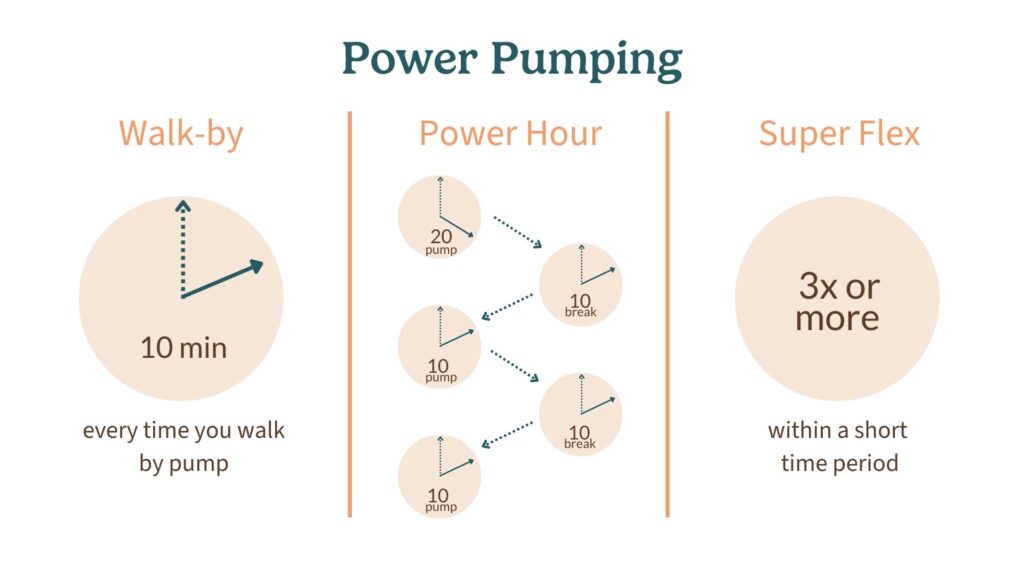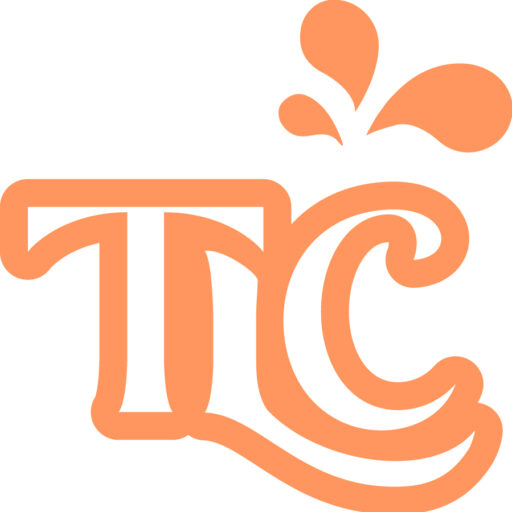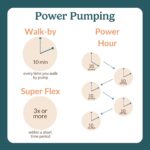power pumping

Power pumping
Power pumping is a technique used to increase milk supply by mimicking cluster feeding, a pattern where babies feed frequently in short bursts.
This method involves pumping in intervals to stimulate your breasts to produce more milk. Power pumping can be particularly helpful if you’re experiencing low milk supply or want to build up your milk stash.
What to watch out for
When starting power pumping, it's important to be aware of some potential challenges and how to address them:
- Nipple soreness: Pumping frequently can cause nipple soreness or discomfort. To prevent this, make sure you use the correct flange size and apply an organic nipple balm before and after pumping sessions. If soreness persists, take a break and consult a lactation consultant. Learn more about using the right flange size.
- Engorgement: Power pumping can sometimes lead to engorgement, where your breasts become overly full and uncomfortable. If you experience engorgement, try hand-expressing some milk or apply a cold compress to bring down the swelling. Learn more about managing engorgement.
- Stress and fatigue: Power pumping requires a significant time commitment and can be tiring. Make sure you’re well-rested and hydrated, and create a comfortable, stress-free environment for your pumping sessions. If it becomes overwhelming, consider reducing the frequency and seeking support from a lactation consultant.
If you experience persistent pain or discomfort, consult a lactation consultant for personalized advice. Schedule a consultation and check your insurance for coverage.
Physical limitations or health circumstances
Certain physical conditions or health circumstances might affect the effectiveness of power pumping:
- Breast surgery: If you’ve had breast surgery, such as augmentation or reduction, it might impact your milk ducts and milk supply. Power pumping can still be beneficial, but results may vary depending on the type of surgery and its impact on your breast tissue.
- Hormonal imbalances: Conditions like polycystic ovary syndrome (PCOS) or thyroid disorders can affect your milk supply. Managing these conditions with your healthcare provider can help improve the effectiveness of power pumping.
- Insufficient glandular tissue (IGT): IGT can lead to low milk supply due to an underdevelopment of milk-producing tissue. Power pumping may help, but it's essential to work with a lactation consultant to develop a comprehensive plan for increasing milk production.
If you have any concerns about your health and how it might affect power pumping, consult a healthcare professional or lactation consultant. Schedule a consultation and check your insurance for coverage.
Other terms
Understanding related terms can help you better grasp the power pumping process and its benefits:
- Cluster feeding: A natural feeding pattern where babies feed frequently for short periods, usually during growth spurts. Power pumping mimics this behavior to stimulate milk production.
- Let-down reflex: The process triggered by oxytocin, causing milk to be released from the alveoli through the milk ducts to the nipple. Effective power pumping relies on a good let-down reflex. Learn more about let-down.
- Prolactin: The hormone responsible for milk production. Power pumping increases prolactin levels, encouraging your breasts to produce more milk.
- Oxytocin: The hormone that causes the muscles around the alveoli to contract and release milk. Stress can inhibit oxytocin, so creating a calm environment is important for effective power pumping.
- Flange size: The part of the breast pump that fits over your nipple and areola. Using the correct size is crucial to prevent nipple damage to effectively remove milk during power pumping. Learn more about using the right flange size.
- Nipple balm: A soothing ointment applied to prevent and treat nipple soreness from frequent pumping. We advise against using lanolin-based creams; use “nipple balms” instead.


